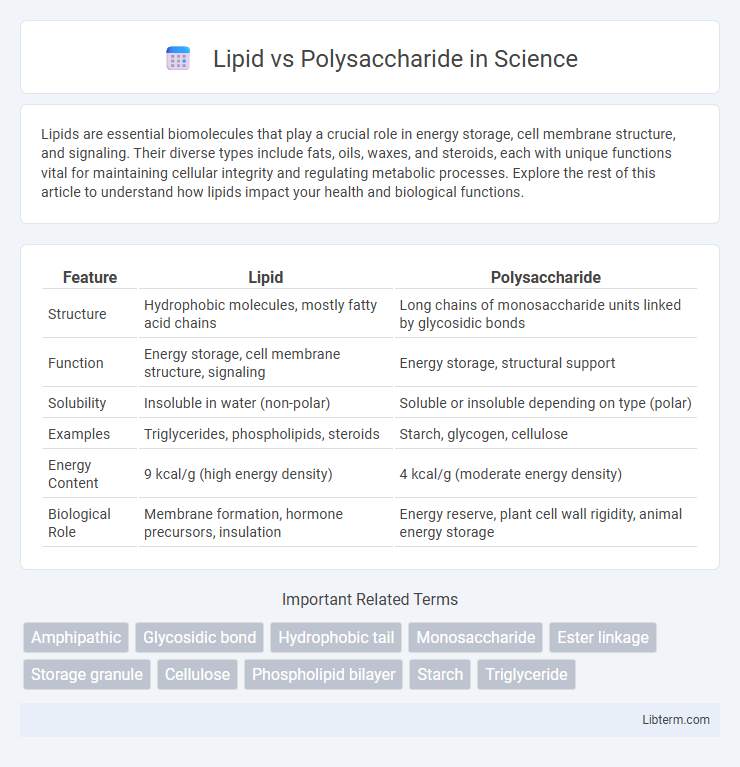Lipids are essential biomolecules that play a crucial role in energy storage, cell membrane structure, and signaling. Their diverse types include fats, oils, waxes, and steroids, each with unique functions vital for maintaining cellular integrity and regulating metabolic processes. Explore the rest of this article to understand how lipids impact your health and biological functions.
Table of Comparison
| Feature | Lipid | Polysaccharide |
|---|---|---|
| Structure | Hydrophobic molecules, mostly fatty acid chains | Long chains of monosaccharide units linked by glycosidic bonds |
| Function | Energy storage, cell membrane structure, signaling | Energy storage, structural support |
| Solubility | Insoluble in water (non-polar) | Soluble or insoluble depending on type (polar) |
| Examples | Triglycerides, phospholipids, steroids | Starch, glycogen, cellulose |
| Energy Content | 9 kcal/g (high energy density) | 4 kcal/g (moderate energy density) |
| Biological Role | Membrane formation, hormone precursors, insulation | Energy reserve, plant cell wall rigidity, animal energy storage |
Introduction to Lipids and Polysaccharides
Lipids are hydrophobic biomolecules primarily composed of long hydrocarbon chains or rings, serving as essential energy storage, cell membrane components, and signaling molecules. Polysaccharides are complex carbohydrates formed by the polymerization of monosaccharide units, crucial for energy storage and structural integrity in organisms. Both lipids and polysaccharides play vital roles in biological systems, but differ fundamentally in chemical composition and solubility.
Chemical Structure Comparison
Lipids primarily consist of long hydrocarbon chains or rings forming nonpolar molecules such as triglycerides, phospholipids, and steroids, characterized by ester linkages connecting glycerol and fatty acids. Polysaccharides are complex carbohydrates made up of repeating monosaccharide units linked by glycosidic bonds, with structures ranging from linear chains like cellulose to branched forms like glycogen. The key chemical distinction lies in the hydrophobic nature of lipids due to nonpolar C-H bonds versus the hydrophilic properties of polysaccharides arising from abundant hydroxyl (-OH) groups.
Types and Classification
Lipids are primarily classified into triglycerides, phospholipids, and sterols, each serving distinct biological roles such as energy storage, membrane structure, and hormone synthesis. Polysaccharides are categorized into storage types like starch and glycogen, and structural types such as cellulose and chitin, crucial for energy reserve and cellular support. The molecular complexity and functional diversity of lipids and polysaccharides underlie their essential contributions to metabolism and cellular architecture.
Biological Functions and Roles
Lipids primarily serve as long-term energy storage, structural components of cell membranes, and signaling molecules in biological systems. Polysaccharides function mainly as short-term energy reserves, structural elements in cell walls (such as cellulose in plants), and participate in cell recognition processes. Both macromolecules are essential for maintaining cellular integrity, energy management, and biological communication pathways.
Energy Storage Differences
Lipids provide long-term energy storage through triglycerides, offering more than twice the energy per gram compared to polysaccharides. Polysaccharides like glycogen store energy short-term and are rapidly mobilized due to their branched glucose chains. Lipid storage is hydrophobic and compact, whereas polysaccharides are hydrophilic and retain water, making lipids more efficient for dense energy reserves.
Structural Roles in Cells
Lipids serve as essential components of cellular membranes, providing structural integrity and fluidity through phospholipid bilayers and cholesterol. Polysaccharides contribute to cell structure by forming rigid frameworks like cellulose in plant cell walls and chitin in fungal cell walls. These distinct molecular structures enable lipids to support membrane dynamics while polysaccharides reinforce extracellular matrices and cellular protection.
Digestion and Metabolism
Lipids undergo enzymatic hydrolysis primarily by pancreatic lipase into glycerol and free fatty acids, which are absorbed in the small intestine and metabolized via beta-oxidation for energy production or stored as triglycerides. Polysaccharides are digested by salivary and pancreatic amylases into monosaccharides like glucose, absorbed through the intestinal lining and metabolized through glycolysis and the citric acid cycle to generate ATP. The metabolic pathways for these macronutrients differ significantly, with lipids providing a denser energy source and polysaccharides offering rapid glucose availability for cellular respiration.
Sources in Diet
Lipids are primarily sourced from animal products such as butter, cheese, and fatty fish, as well as plant oils like olive and coconut oil. Polysaccharides are abundant in plant-based foods including whole grains, legumes, vegetables, and fruits, providing complex carbohydrates for sustained energy. Both macronutrients play distinct roles in nutrition, with lipids offering energy-dense calories and polysaccharides supplying fiber for digestive health.
Industrial and Medical Applications
Lipids serve as essential components in pharmaceutical drug delivery systems due to their biocompatibility and ability to form liposomes for targeted therapy, while polysaccharides are widely utilized as biodegradable polymers in medical implants and wound dressings. Industrially, lipids find applications in the production of biofuels and emulsifiers for food and cosmetics, whereas polysaccharides like cellulose and chitosan are key in biodegradable packaging, water treatment, and as thickeners or stabilizers in various manufacturing processes. Their distinct chemical structures enable lipids to offer hydrophobic interactions ideal for encapsulation technologies, while polysaccharides contribute hydrophilic properties crucial for scaffold materials and sustained-release drug formulations.
Key Differences and Summary
Lipids are hydrophobic molecules primarily composed of fatty acids and glycerol, serving as energy storage, insulation, and cell membrane components, while polysaccharides are long chains of monosaccharides that function mainly as energy storage (e.g., starch, glycogen) and structural support (e.g., cellulose) in plants and animals. Lipids are non-polar and insoluble in water, whereas polysaccharides are polar and generally water-soluble or gel-forming due to their extensive hydroxyl groups. The key differences lie in their chemical structure, solubility, and biological roles, with lipids providing long-term energy and membrane structure, and polysaccharides offering instant energy and mechanical strength.
Lipid Infographic

 libterm.com
libterm.com